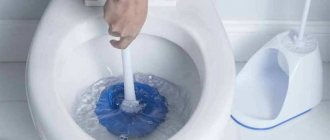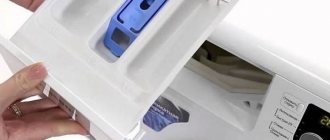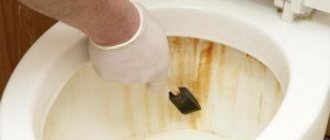It is almost impossible to teach even the smartest cat to go to the toilet on a schedule. Pets that have access to the street and relieve themselves outside the apartment or house go for a walk and “run errands” several times a day, while domestic cats use the litter box. Some owners prefer to pour various types of litter into the cat litter box, while others leave the bottom of the litter box. Regardless of how the tray is used, it needs to be washed regularly. How to wash a cat's litter box? Below we will look at the most popular means that can effectively get rid of the smell in the cat's litter box and wash away dirt.
How to wash a cat's litter box?
Why does a cat walk past a clean litter box?
Unfortunately, a clean tray is not a 100% guarantee that your pet will not crap in the apartment. Don’t rush to scold, much less punish, the cat. First, find out the reason for the destructive behavior.
- Repels the smell of the litter box. It is not a fact that a product that smells pleasant to you will be liked by your cat. Try cleaning the toilet with water only next time and see how your pet reacts.
- Presence of moisture. A cat may refuse to go to the litter box if it notices wet walls. It is also possible that she associates the smell of wet litter with dirt, dampness and mustiness.
- Bad filler. Many cats prefer clumping rocks made from minerals or clay. Although silica gel fillers absorb foreign odors well, they scratch the paws. Not all pets like to go to a tray with bars. Also, a sudden change of litter can lead to a refusal to visit the cat litter box.
- Cystitis, urolithiasis or other health problem. If your cat not only shits, but also refuses to eat, looks lethargic, and makes strange sounds, take her to the vet.
Thus, cleaning a cat's litter box is a responsible undertaking.
While cleaning, it is important to think about your pet. Will the remaining dirt on the walls of the tray, the strong smell of detergent or excess moisture scare him away?
If you do everything correctly, the cat will remain grateful and stop crap in the apartment.
Need for washing
The need to clean a pet's toilet occurs very often, especially when the animal is an adult. It is not enough to simply change the filler; this will lead to rapid deterioration of the material. If the tray is not washed, the following problems arise:
- an unpleasant odor appears that is absorbed into the material from which the toilet is made;
- microbes multiply and can contribute to the appearance of diseases in the animal;
- fleas appear in the room, laying their eggs in the area where the toilet is located;
- a dirty toilet can lead to animal diseases;
- the animal refuses to go to the tray.
Failure to wash the tray contributes to the accumulation of urinary stones, which often leads to complete unusability of the container.
How to disinfect cat litter?
If the tray is new and cleaned regularly, then it practically does not emit unpleasant odors. But over time, microscratches form in the plastic bottom, into which particles of urine, feces and dust become clogged. The question arises: how to wash the tray without smelling?
Modern means
Household and pet stores sell special products for cleaning cat litter boxes and eliminating unpleasant odors. Why is it better to use them for disinfection purposes?
- They do not cause allergies in pets and are safe in case of licking.
- Eliminate stubborn urinary stone stains on the bottom and walls.
- They have a neutral or pleasant smell for cats, which means that animals will not refuse to go to the tray after cleaning.
- Does not leave scratches.
- Eliminates odors of urine and feces.
The only drawback of modern products is the high price (500-800 rubles) compared to ordinary soap or baking soda.
Common Home Remedies
How to disinfect a cat's litter box if your budget is limited or you're just too lazy to go to the store? You can use regular detergents:
- laundry or baby soap (grate the shavings and dissolve in water);
- liquid soap;
- a mild detergent, such as delicates powder;
- dishwashing liquid;
- baking soda - 2 tablespoons per 200 ml of water.
It is important to choose a product without a strong odor, and at the end, thoroughly rinse the cat’s litter box in clean water, preferably several times. Cats especially do not like the scents of citruses and coniferous trees.
If the smell remains on the walls, the pet will pass by its toilet and relieve itself somewhere in a corner or on the carpet.
What absolutely cannot be used for disinfection?
- products containing chlorine - there is a high probability of poisoning when licked and inhaled;
- vinegar - most likely, due to the pungent smell, the cat will prefer another toilet place to the tray;
- powders like "Pemolux" - leave scratches on the plastic surface of the bottom.
Don't forget to clean the area around the tray. After relieving itself, the pet often digs into the litter: lumps fly to the floor, and dust rises into the air. Dirt near the toilet may be one of the reasons why a cat has a desire to shit in the apartment.
How to avoid blockages
- straighten the hanger with pliers, leaving the hook;
- tie a rag to the other end of the hanger - it will protect the toilet and pipes from damage;
- Pour dishwashing liquid, shampoo or gel into the bowl to make cleaning easier;
- insert the end of the hanger, wrapped in a rag, into the toilet until it clogs;
- Punch through the cork using a back and forth motion with the hanger.
Toilet spiral.
This is a cable on a long stick with a handle. It is easier to use than a regular metal cable. Brief instructions:
Removing cat urine from shoes
As soon as traces of a pet's crime are noticed, it is necessary to place the shoes under cold water, treat the shoes with potassium permanganate and wash them (either in a washing machine or by hand). Then, of course, it is advisable to dry it outside, but if this is not possible, a loggia will do.
You can wash soiled shoes with laundry soap with a high glycerin content, which very easily breaks down cat urine crystals.
If a cat shits in shoes that cannot be washed (boots, shoes), then the first thing you need to do is get rid of the insoles, where most of the liquid has been absorbed. Wipe the remaining internal parts with a vinegar solution or potassium permanganate and leave to dry in the fresh air (street, balcony).
You can also use an alcohol solution of iodine to clean shoes, but this product can only be used on dark shoes; marks may remain on light shoes. It is very simple to prepare such a solution: add 10 drops of iodine to 1 liter of water.
https://youtube.com/watch?v=Nyh6nMfzHQw
https://youtube.com/watch?v=Nyh6nMfzHQw
How can you wash a cat's litter box without litter to prevent it from smelling? how to clean it from urinary stone?
How to wash a cat's litter box and how to remove urinary stones? A huge number of owners of domestic cats and especially cats are looking for the answer to this question every day. For those who do not yet have a furry pet, but the thought of the need to acquire a new friend has not left for a long time, such knowledge will also not be superfluous.
First of all, future owners study information about the rules of nutrition and keeping animals. But in the realities of life, people most often face not so much these difficulties as the problem of the smell emanating from the cat’s potty. This will especially complicate life for those who keep the animal exclusively at home, without letting it go outside at all. Daily washing of the tray for collecting feces eventually ceases to relieve the stench, and the “cat spirit” can already be felt far beyond the confines of the bathroom. This happens not because the tray was not washed, but because it was done incorrectly. Increased odor may also be caused by urinary stone growths.
For a comfortable neighborhood, you need to learn as much as possible about the proper care of cats and their litter boxes. The nuances of washing and the secrets of preventing odor will be revealed in this article. Choose the appropriate option for yourself and enjoy living together with a fluffy and mustachioed purring bundle!
Chechen authorities showed a video of a judge’s wife being taken to Grozny by security forces
The woman in the footage speaks with difficulty and confuses her words. Zarema Musayeva, who was forcibly taken from her home by Chechen security forces, is a witness in a criminal case, Kadyrov said.
Tele on Instragram published a video of Zarema Musaeva, the wife of former judge of the Supreme Court of Chechnya Saydi Yangulbaev, taken away by Chechen security forces from Nizhny Novgorod. A woman with diabetes, in a conversation with the human rights ombudsman in Chechnya, Mansur Soltaev, says that she was given the necessary medications and that no violence was used against her.
The footage shows that the woman speaks with difficulty and confuses her words. In response to Soltaev’s leading questions, she answers in the affirmative.
“I am now convinced that no violence was used against you, your condition is now. We understand, you are insulin dependent, the doctor will examine you now. We are keeping the issue under control,” he says.
How I found my ideal hair growth product
Hello dear! I want to share with you my solution to the sensitive problem of hair loss . The problems are very serious, at least for me. I would never have thought that this misfortune would touch me, especially at the age of 29 (read more...)
“This is pure hell. I have no words. I don't believe that this can happen in Russia. I know my mother, and now in the video she is in a very serious condition and simply no good,” her son, Abubakar Yangulbaev, commented on the appearance of the video.
On January 20, in Nizhny Novgorod, armed people in civilian clothes broke into the apartment of the former judge of the Supreme Court of the Chechen Republic, Saydi Yangulbaev, and kidnapped his wife Zarema Musaeva.
In his statement, Kadyrov also demanded that Yangulbaev be deprived of his status as a judge and threatened that the family of the ex-judge “ will face a place either in prison or underground
».
Presidential press secretary Dmitry Peskov, in response to a request to comment on what happened, called the story of the kidnapping “ fiction
” and stated that the Kremlin prefers not to believe such reports without confirmation.
In accordance with the federal law “On the status of judges in the Russian Federation,” a judge, members of his family and their property are under special protection of the state. This right remains with them even in case of resignation.
How to wash a cat's litter box to avoid smell?
The cat is an extremely clean animal that prefers to go to the toilet in one specific place, usually the litter box. How to wash a cat's litter box, and how to get rid of an extremely unpleasant odor if ordinary cleaning products are not effective?
Why and how to wash the tray
How to wash a cat's litter box to get rid of an unpleasant odor is a question that not all pet owners are concerned about. Many of them believe that the unpleasant odor goes away along with the filler and the remains of feces, but this is not so. If the pet owner does not clean the litter box for a long time, does not wash it, and does not remove the remains of feces, the cat may stop going in it. Distinguished by extreme cleanliness, the animal simply cannot go to the dirty toilet. In addition, the smell from such a tray is not the most pleasant.
Most often, pet owners prefer to clean the tray using conventional disinfectants. Such store-bought emulsions are good because they not only eliminate odor, but also destroy all possible bacteria on the surface of the cat litter.
If for some reason a person does not want to use commercial disinfectants, you can treat the tray with hydrogen peroxide. It should be diluted in a ratio of 1/4 with water, thoroughly rinsing not only the tray, but also the top grid. Peroxide also perfectly fights bacteria and destroys microbes accumulated on the surface. Some cat owners add a little lemon juice to the solution to give the litter a pleasant smell. However, resorting to lemon juice may cause the animal to stop using the litter box, disliking the new smell coming from the litter box.
Veterinarians advise changing the litter at least once a month, simultaneously getting rid of excrement. You should also wash the litter box itself once a week, because a dirty litter box can cause your cat to pick up dangerous germs from its own feces.
How else can you wash a cat's litter box?
Many pet owners prefer to treat the tray with a solution of potassium permanganate. Ideally, potassium permanganate should be diluted in a ratio of 1/3 or 1/4. Use this solution to rinse all parts of the tray, after which you need to place the toilet under regular running water. Another great disinfectant is a vinegar solution. A couple of tablespoons of vinegar should be diluted in warm water, rinsing the cat litter with the mixture. This product is odorless and perfectly removes dirt.
You can get rid of really strong stains with baking soda. The pet owner can dissolve a couple of tablespoons of baking soda in water, rinsing the entire tray with the mixture, or can use this product in dry form. Apply baking soda to a rag and start wiping away old feces with it.
Using bleach-based solutions can only harm your cat's ability to relieve itself in one place. A product with such an unpleasant and obvious odor will force the animal to look for a new place to toilet. That is why when treating with purchased products, you should make sure that they contain a minimum amount of bleach. You should not treat the cat's litter box with solutions that contain a lot of flavorings. Such flavors can also scare a cat away from a well-known place, forcing him to walk around small and large in forbidden places.
Few people know that pregnant women should not clean cat litter boxes. The fact is that from the remains of cat excrement you can pick up a bunch of diseases, including the dangerous bacterium toxoplasma, which can harm the normal development of a child.
Correct and timely cleaning of the litter box is the key to ensuring that your cat will always go to the toilet in one designated place. In addition, with timely cleaning, a person reduces the risk of spreading dangerous bacteria throughout the house.
How to choose the right tray
The type of tray for a pet depends on the age of the animal and the preferences of the person. There are various types of products with mesh and simple ones on sale. Toilets in the form of closed houses are gaining popularity.
Dry toilet
It looks like a small product with a lid. The advantage of such a device is that there is no unpleasant odor. The device prevents the filler from spilling and has a special bacterial wipe that removes harmful microorganisms. The upper part of the dry closet is removed, resulting in an open toilet. This function is necessary in order to accustom the animal to this type of toilet. The disadvantage of such a product is the cost.
Closed
The device looks like a container with a special door. Such toilets protect the room from unpleasant odors. The device has a special lid that closes after visiting the toilet. Another advantage of this device is that the filler always remains inside and does not scatter. The disadvantage of the product is that not all cats accept such a toilet; some refuse to use it.
See also
Instructions on how to clean the ventilation in your apartment yourself
With automatic cleaning
The design involves automatic cleaning of the tray after the animal uses the toilet. The product reacts to the movement of the animal and cleans the tray independently. The used filler is placed in a container. The product is expensive, but the advantage of this type of toilet is that it does not need to be cleaned. Simply remove the filler from the container.
The disadvantage of this device is the noise during cleaning. Many cats refuse to use a litter box that turns on during a visit.
Traditional methods
Traditional methods allow you to clean the tray without using harmful household chemicals. We use products that are available in every home.
Soda
You can wash your cat's litter using baking soda. To do this, you need to perform the following algorithm of actions:
- clean the pot from the filler;
- wash off any remaining filler;
- Apply a thin layer of baking soda and leave for 5-10 minutes;
- Using a brush, remove the stone and wash the product under running water.
The benefit of using baking soda is that it removes harmful microorganisms. Also, soda can cope with even the most difficult plaque.
Laundry soap
Using soap will allow you to clean the tray if it is only slightly dirty. Laundry soap does not damage the surface of the tray and forms a protective film that prevents the reappearance of the stone. To use, make a thick foam, apply to the tray and rub thoroughly with a brush. Then rinse with water and wipe with a cloth.
Important. If you cannot remove the urinary stone the first time, you can soak the product overnight in a solution of laundry soap.
Vinegar
You can remove plaque using table vinegar. To do this, dilute a glass of vinegar in a liter of water and fill the tray. Leave for 5-10 minutes, then brush and rinse. To remove the smell, rinse the tray well with running water. Vinegar not only eliminates unpleasant odors, but also kills harmful bacteria.
Professional products
Using professional methods allows you to eliminate urinary stones in one procedure. To clean the tray, the product is applied and distributed over the entire surface with a brush. Leave for 10 minutes and then wash off. The following types of drugs can be used:
- "Line";
- "Delix Charm";
- "Liquidator";
- "Estilodez".
For small cats, preference should be given to products with a mild effect. Fragrance-free preparations with anti-allergenic properties are selected.
How to wash
If the stone has just begun to form, the cleaning process will not cause difficulties. For advanced stages, some effort is required.
Tools
Before starting the cleaning process, it is important to have all the necessary tools ready. This is necessary to reduce contact with a dirty object.
Trash bag
Used to remove filler. The cat litter that is placed in the pot has a distinct unpleasant odor. Therefore, after the filler has been placed in the trash container, the bag must be tied. This will reduce the risk of spreading an unpleasant odor in the room.
Tap water
There should be plenty of water to wash away the remaining stones and completely clean the tray of dirt.
Detergents
It is very difficult to remove urinary stones without the use of special cleaning products, so before carrying out the cleaning procedure it is necessary to prepare a product that will dissolve the stone and allow it to be quickly removed.
Hard brush
Use a brush with a long handle. This type of brush is used for cleaning without the person encountering dirt too often.
Clean rag
After the tray is cleaned and washed off with water, you need to wipe it using a rag. Only after this is new filler added. It is better to use a soft cloth that absorbs moisture well.
See also
What can and cannot be washed in the dishwasher and why so
Gloves and respirator
A prerequisite before starting to clean the tray is to prepare rubber gloves that will protect your hands from harmful microorganisms and household chemicals.
A respirator is necessary to reduce the inhalation of the foul odor that appears in the cat's litter box.
Method for cleaning complex toilet stains
The fundamental way to clean the toilet from urinary stone and limescale is to use electrolyte (which is poured into batteries). When resorting to this method, you must work very carefully, be sure to wear rubber gloves, preferably goggles, and try not to inhale the fumes
Be careful when pouring liquid into the toilet to avoid splashing, which could get on your skin or clothing. This method can only be used if the pipes to the riser from the toilet are not plastic
Preventing the formation of plaque on the toilet
It happens that the cause of plaque is a malfunction of the toilet. In this case, you should try to eliminate the leak as quickly as possible. To avoid constantly flowing water, sometimes simply adjusting the float is enough. Sometimes you have to make more serious repairs, replacing some gaskets with new, more durable ones.
Special tablets for the toilet can help prevent the problem of limescale and urinary stones in a timely manner. Even if it has already appeared (in small quantities), the tablets will save you from plaque and help keep the toilet clean.
If you systematically, at least once a week, treat the toilet with cleaning agents, it will last much longer, and it will not be spoiled by an unpleasant red coating.
To prevent the re-formation of stones, you need to wash the toilet once a week with warm water and powder. Everything is simple here: the powder must be diluted in warm water and the surface of the toilet bowl must be cleaned from the inside with a regular abrasive sponge.
How to clear a clogged toilet
The blockage can be cleared using potato water. To do this, you need to pour boiling water into the drain and wait about 5 minutes. During this time, the sewer should clear. In addition, you can pour baking soda into the drain holes and turn on hot water after a few minutes. Baking soda will not only remove blockages in pipes, but also remove unpleasant odors from pipes.
To prevent the toilet and drain from becoming clogged, for preventive purposes, you can pour a bucket of hot water into it once a month. This is much easier and better than cleaning it with chemicals later.
Now you know several simple ways to clean a toilet quickly and effectively. I would like to believe that such troubles as limescale and urinary stone will no longer bother you, and your toilet will always be clean and sparkling.
What not to do
Mistakes in clearing a clogged toilet can make the situation worse. When working, follow the recommendations:
- Follow the manufacturer's instructions. If the remedy does not work, this does not mean that you need to increase the dosage. Most likely, you incorrectly identified the cause of the jam and chose the wrong chemistry.
- Make sure the method is suitable for your type of pipe. Be careful with caustic compounds, such as caustic or soda ash, sulfuric acid. If used incorrectly, the substances can damage the inner surface of the pipes.
- Do not pour bleach or other chlorine-containing products into the toilet - they do not cope with blockages, and their fumes are harmful to health.
What folk remedies will help wash
To clean your cat's litter box, you don't have to buy expensive store-bought chemicals. The funds available in every home will come to the rescue. The main thing is to know the rules for their use and cleaning methods.
Table vinegar
To clean with table vinegar, you need to heat the substance to forty °C and fill the tray so that all the plaque is in the liquid. In this state, the container should stand for a certain time. If the contamination is shallow, then one hour will be enough. In case of heavy contamination, you must wait at least three hours. As time passes, you need to drain the vinegar and clean the pot with a brush and abrasives. Clean until the surface of the tray becomes smooth. Then rinse it with warm water and wipe dry.
Baking soda
It is used for mechanical stone removal and disinfection. You need to start by washing the tray. Next, dry soda must be poured onto the rough surface and rubbed into the urinary stone with a brush until it is removed. After the procedure, the cat litter box is rinsed again with warm water and dried outside.
Laundry soap
Soap must be dissolved in hot water. A soap solution is poured into a large container and parts of the tray containing urinary stone are placed in it. Next, the tray soaks for 24 hours. After this, the stone is removed with a stiff brush, and the pot is rinsed with water and vinegar.
Mustard powder
Mustard powder is applied to the wet surface of the tray and rubbed with a stiff brush into the surface damaged by the urinary stone. After cleaning, rinse the container with water. This cleaning will not only get rid of the stone, but will also help get rid of animal marks on different surfaces.
What should you do to clean it?
If everything already “looks bad” and there is urinary stone in the tray and a literally suffocating smell, do not be upset - you can get rid of both in one intensive procedure. What will she need?
- Respirator and gloves to protect hands and respiratory tract;
- Garbage bag for used litter;
- Water;
- Clean cloth;
- A hard brush, not a kitchen brush, and especially not in grease;
- Detergents.
First of all, you should put on a respirator and gloves - the smell will be less annoying and you won’t be afraid of catching common cat parasites. Then the pot should be placed entirely in a garbage bag, turned over and carefully shake out all its contents, lightly tapping the bottom. It is better to throw away the resulting garbage immediately.
Not all animals take chemicals well, so traditional methods of cleaning the tray come to the rescue. The products that almost everyone has in their home will help you deal with formations: vinegar, baking soda and laundry soap. Making a cleaner couldn't be easier.
Add soda to warm water (half a glass will be enough), pour it into a tray and clean the surface with a stiff brush until the stone comes off. If there is a strong unpleasant odor, you will need 2 tablespoons of soda per 0.5 liter of water. Pour the solution into the cat litter and leave it overnight (or several hours). The next morning you can easily wash off the formations.
Vinegar perfectly disinfects and easily removes contaminated areas. In addition, it helps cope with unpleasant odors. Vinegar is added to the tray when cleaning and washed with it. Laundry soap is best used before plaque appears - it keeps the material in good shape and prevents the formation of urinary stones.
How to quickly clean a cat's litter box, watch the video below.
General cleaning of the cat potty
Although using hygienic litter for cats reduces daily cleaning efforts, it requires thorough washing at least once a week. It is necessary to clean the cat litter not only because the smell spreads from it, but also so that the cat does not want to “do business” in the right place, and does not choose a more secluded and clean corner. An attentive owner will not allow a strong odor to appear from the tray, already knowing how often cleaning should be done. What is required for this?
Preparing to clean your cat's litter box
To quickly and effortlessly wash your cat’s weekly litter box, you should prepare the following:
- rubber gloves and respirator mask;
- spacious garbage bag;
- detergent (we will talk about the choice below);
- sponge or cloth.
Using gloves will help avoid infection with parasites or toxicoplasmosis.
Cleaning process
The old filler needs to be shaken out into a bag, putting it on the tray so as not to spill. The garbage bag must be tied tightly immediately, preventing the smell from leaking out. Check that the bag does not have holes, otherwise there is a high chance of spilling soiled filler throughout the apartment. If you are not using pot filler, this step is of course unnecessary. Next, you need to take the tray to the bathroom, rinse thoroughly under running cold water, and then begin cleaning it with detergent.
Over time, stains may form on the bottom and walls of the cat's litter box, as well as urine stone, which has a persistent unpleasant odor. It is not so easy to wash away the consequences of a cat visiting the toilet, but using proven products, the owner can achieve pristine purity of the plastic. You can use both folk remedies and store-bought ones.
Life hack: some owners specifically buy an inexpensive toilet brush and use it to clean the cat’s litter box. It is very comfortable! After washing the tray, the toilet brush is rinsed with cleaning agent and put into the stand.
How to remove odor
If the tray stinks even after washing, it is necessary to use special preparations that block the smell. You can also use the proven method and before adding the filler, spread a thin layer of soda on the bottom of the tray. This action will remove the odor and absorb excess liquid.
You can also remove the unpleasant odor using special napkins, which are lined at the bottom of the pot and filler is poured on top. This napkin is effective for a week.
Daily care rules
In order for the urinary stone to be easily cleared, it is necessary to follow the rules of daily cleaning. The rules look like this:
- Clean up feces daily. Regardless of the state in which the filling is, it is necessary to have a special spatula for comfortable removal of waste.
- Remove lumps in litter daily.
- Check the condition of the filler. If it is already dirty, it needs to be replaced.
See also
How to quickly and effectively clean ugg boots at home
The filler must be changed for an adult animal every 3-4 days. Daily replacement is not necessary unless there is an unpleasant odor.
To ensure that the daily cleaning of the toilet does not cause difficulties, general cleaning is carried out every 7-10 days. During cleaning, the following precautions must be observed:
- change the filler;
- cleanse urinary stones;
- disinfect the cat litter;
- rinse the product well so that the disinfectant does not get on the cat’s mucous membranes;
- wipe with a napkin;
- add fresh filler.
The procedure for cleaning the cat litter box is carried out regularly. It is unacceptable to postpone the hygiene procedure until next time.
Important. To quickly remove the litter, simply place a garbage bag on the pot and shake it out.
Video
Some more useful information is presented in the video below:
Text: Nadezhda Chernobay
Found a mistake? Select the text with the mouse and click:
There are special traps to combat moths. The sticky layer with which they are covered contains female pheromones that attract males. By sticking to the trap, they are eliminated from the reproduction process, which leads to a decrease in the moth population.
Stretch ceilings made of PVC film can withstand from 70 to 120 liters of water per 1 m2 of their area (depending on the size of the ceiling, the degree of its tension and the quality of the film). So you don’t have to worry about leaks from neighbors above.
If your favorite things show the first signs of gestation in the form of untidy pellets, you can get rid of them using a special machine - a shaver. It quickly and effectively shaves off clumps of fabric fibers and returns things to their proper appearance.
Fresh lemon is not only suitable for tea: clean dirt from the surface of an acrylic bath by rubbing with half a cut citrus, or quickly wash the microwave by placing a container of water and lemon slices in it for 8-10 minutes at maximum power. The softened dirt can simply be wiped off with a sponge.
The dishwasher cleans more than just plates and cups. You can load it with plastic toys, glass lamp shades and even dirty vegetables, such as potatoes, but only without using detergents.
The habit of using an automatic washing machine “sparingly” can lead to the appearance of an unpleasant odor in it. Washing at temperatures below 60℃ and short rinses allow fungi and bacteria from dirty clothes to remain on internal surfaces and actively multiply.
The easiest way to remove scale and carbon deposits from the soleplate of the iron is with table salt. Pour a thick layer of salt onto the paper, heat the iron to maximum and run the iron over the salt bed several times, applying light pressure.
Threads made of gold and silver, which were used to embroider clothes in the old days, are called gimp. To obtain them, the metal wire was pulled for a long time with pliers to the required fineness. This is where the expression “to drag out the rigmarole” came from - “to do long, monotonous work” or “to delay the completion of a task.”
Before removing various stains from clothing, you need to find out how safe the selected solvent is for the fabric itself. It is applied in a small amount to an inconspicuous area of the item from the inside out for 5-10 minutes. If the material retains its structure and color, you can move on to stains.
Cats are very clean animals who prefer to go to the toilet in the same place. Pets who do not have access to the street choose a litter box for their business. But over time, plaque and urinary stones form on it. Some owners do not attach much importance to this and are in no hurry to clear the tray of urinary stones. But if the plaque is not removed in a timely manner, then a heavy and unpleasant smell will constantly hang in the apartment.
Eliminating cat urine from upholstered furniture
How can you wash cat urine off a soft surface? Many cat owners ask themselves.
This procedure consists of several stages; when working, it is better to use disposable rubber gloves:
- It is necessary to prepare disposable towels or napkins, table vinegar, soda, hydrogen peroxide, dishwashing gel, as well as a container for spraying liquid. Use a paper towel or napkins to absorb any remaining liquid on the surface.
- A stain that has already dried naturally or unnaturally must be treated with a vinegar solution, based on 1 glass of vinegar and 3 glasses of running water. Spray the solution onto the stain, cover with paper and leave until completely dry. Acetic acid will destroy the urine contained in the urine.
- After complete drying, generously sprinkle the contaminated area with baking soda, which perfectly absorbs unnecessary odors.
- Pour 300 ml of water, 150 ml of hydrogen peroxide and 30 ml of dishwashing gel into a container with a spray bottle, mix everything well, shaking the container with liquid. Spray the stain generously with the resulting solution until foam appears. And leave it in this state for several hours. Bad-smelling carpet or upholstered furniture should be completely cleaned and stop smelling.
- Thoroughly rinse the wash area with a washing vacuum cleaner or a regular rag soaked in plain water.
You can wash off cat urine in an apartment on hard surfaces in a similar way; it will take much less time and effort.
To remove cat urine, you can use specialized products. But many of them only mask and do not eliminate the odor, enveloping urinary crystals with their chemical elements.
This means that whenever the surface gets wet, the smell will reappear. And even if the owners do not feel it, a cat with a heightened sense of smell will smell its own smell and it is possible that it will repeatedly go to the toilet in the wrong place. It is also worth noting that some chemicals interfere with the removal of the nuisance using peroxide, soda and other substances. That is, it will never be possible to get rid of the smell in this way, and it will be quite problematic to wean the animal from shitting in this place.
To eliminate unpleasant odors from the apartment, you can use fragrances. These can be aroma lamps, air fresheners, coffee and other products. But using this method alone will not solve the problem, and the pleasing result will only be a temporary effect. “Aromatherapy” should be carried out in conjunction with some effective method of removing cat urine.
What do you think about it? , your opinion is important to us
Causes of pungent odor
The pungent aroma is due to the chemical composition of cat urine. Its main component is uric acid, which crystallizes when dried. When in contact with moisture, the colorless crystals begin to smell strongly; in addition, they are difficult to remove from surfaces and do not dissolve in water, so they represent the greatest problem in the fight against stench.
The persistent smell has a natural meaning: this is how cats mark territory, warning their opponents about the boundaries of their possessions. Marking is also associated with the search for a partner, so the urine of uncastrated individuals smells stronger due to the hormones it contains. With infections of the urinary system, the smell can intensify and become more pungent, so its constant presence despite proper toilet hygiene is a cause for concern.
Tips and warnings
In order for the animal not to stop going to the toilet, it is necessary to follow some tips and recommendations depending on the characteristics of the animal.
Castration
Neutered cats have more potty requirements. Animals require larger toilets. Preference should be given to toilets with mesh. Since ordinary trays can be uncomfortable for cats.
How to choose a filler
The filler should not contain any foreign odors. The most commonly used filler is wood or clay. In order to choose the right one, you need to try species until the animal determines the most suitable one. You should not skimp on the filler; the better the substance absorbs moisture, the less germs and unpleasant odors are formed. Cheap litters quickly require replacement and often do not absorb urine at all.
How often should you change the tray?
The device must be changed once a year. Even with frequent cleaning, the material absorbs an unpleasant odor and can repel the animal.
Choosing a time to clean
Many cats visit the litter box at certain times. Therefore, it is necessary to change the litter when the animal does not visit the toilet. In the absence of filler, the cat can go anywhere, thereby causing trouble for the owner.
Toxoplasmosis
To avoid contracting toxoplasmosis, you must use a respirator. This device is inexpensive, but allows you to protect the respiratory organs. A new respirator must be used before each fill change.
https://youtube.com/watch?v=locM6SNkV28
A cat tray is one of the main items that must be selected individually for each animal. It is necessary to accustom a cat to the toilet from birth, so the tray changes depending on the age of the animal; adults can use a product with high sides or a closed type
It is also important to promptly remove feces and clean the product from urinary stones, otherwise the cat litter will cause problems for the animal and an unpleasant odor in the home
For a very long time I was looking for a way to remove stone deposits from urine from the pot. Neither the pemos nor the folk remedies that were advised to me helped me, and it is very difficult to chip off the plaque with something sharp and traces remain ((
but I found the easiest way out in my opinion. I bought Silit Beng toilet gel and poured it into the pot. The first time I diluted it a little with water, the second time I didn’t dilute it. Pour the gel so that it covers the plaque, leave for 3-4 hours if the plaque is strong, I think 2 hours is enough if not very much. I put the pot in my T-shirt and tied it, because the smell is strong. then drain the product and rinse the pot with clean water until the gel is completely washed off. The result is that the pot is clean, not a drop of residue.
I hope it is useful to someone
If you don't take care of your toilet properly, one day the dirt will have to be scrubbed off.
It is important to know how to clean a toilet from urinary stones and which products are most effective. A urine stone forms gradually on the rim and outlet due to irregular rinsing of urine and poor cleaning; at first it looks like a plaque
If it is not removed and care is not taken in the future, the plaque will thicken and turn into urinary stone.
If you don't take care of your toilet properly, one day the dirt will have to be scrubbed off.
Step by step process
Before you start cleaning your cat's litter box, you need to put on a mask and gloves. Next, you should clean the toilet in any way and remove the old litter. To carry out this procedure, they usually take a garbage bag, place a tray in it, and turn it over. After this, the bag is immediately thrown away.
The next step involves washing thoroughly under hot running water. The tray must be completely cleaned of feces and remnants of old litter. To thoroughly clean the tray and eliminate the smell, you can add any plumbing cleaner to it and use a brush to actively wipe the toilet.
Sometimes urinary stone is deposited in a thick layer and is no longer so easy to wash off. Then the detergent must be applied over the entire surface (you can use stronger detergents, for example, Sanox), and leave for some time, for example, 40-60 minutes. This time will be enough for the plaque to move away from the tray. At the end you just need to rinse it with water.
Please note: new litter should only be placed in a dry tray.
Ways to get rid of odor
Cats are one of the most common pets. Manufacturers of pet products offer a large number of different products to get rid of the smell of cat litter. Resourceful housewives, in turn, instead of expensive chemicals, use improvised means to effectively clean the animal’s tray.
What does chemical production offer?
Relatively recently, cat owners used improvised means such as pieces of newspaper, sand and sawdust as filler. They absorbed liquid quite well, and the sawdust even absorbed the unpleasant odor. However, the paper had to be changed frequently, and sand and sawdust quickly spread throughout the house. Today, many special fillers are produced that have a large number of advantages.
Fillers for trays are divided into several main types depending on the principle of action and composition:
The video below clearly demonstrates the properties of various modern fillers:
Regardless of which filler is chosen, owners should monitor its condition and change it as it becomes dirty. Moreover, cats are very clean creatures and many of them will not use a dirty litter box. Cleaning will not take much time. All you need to do is remove the contaminated sorbent and add clean material. The frequency of complete litter replacement depends on its type and the number of animals in the house.
Traditional methods
If an unpleasant smell from a cat's litter box has spread throughout the apartment, you can get rid of it using substances that almost every housewife has on hand.
If your cat's litter box stinks even after you've cleaned it and completely removed the feces, it's most likely caused by uric salts that have accumulated on the sides of the litter box. Regular table vinegar, which is recommended to be periodically poured into the tray for 30-60 minutes, will help deal with plaque. After this procedure, the stone is easy to clean with a brush or sponge. The container will become clean and the vinegar aroma will quickly disappear.
Hydrogen peroxide and regular baking soda are effective means of using a chemical reaction to eliminate unpleasant odors and wash away dirt. The surface to be treated should be generously covered with soda. After preparing a solution consisting of 100 ml of hydrogen peroxide, 0.5 teaspoon of detergent and 100 ml of water, pour it into a spray bottle. Sprinkle the product evenly over the baking soda and leave for 2-3 hours. After the time has passed, remove the composition and rinse the tray thoroughly with water. There will be no trace left of the pungent odor.
If the kitten is not yet accustomed to going to the toilet in a specially designated litter box, the owners have to deal with the unpleasant odor emanating from secluded places. Helpers in this case can be:
- Whiteness is a chlorine-containing liquid with a pungent odor. A surface treated with this product will permanently discourage the kitten from voiding in the wrong place.
- Ammonia. To quickly accustom your animal to the litter box and eliminate the unpleasant odor, you can treat the surface with this product, similar to white, or you can soak cotton balls and place them in the cat’s favorite places.
A solution of potassium permanganate and laundry soap are effective means at hand that can not only eliminate the foul odor, but also clean and disinfect the contaminated surface.
This video allows you to see how easy it is to remove the foul odor from the tray using improvised means:
Castration
Some people believe that if they neuter their pet, they can avoid unpleasant litter box odors. This statement is only partly true. Because the operation must be carried out strictly until a certain age (this applies to both cats and cats).
And it happens that the animal is already more than a year old, the owners sniff it and run to the clinic. Unfortunately, in this case, castration will not solve the problem. There will still be a specific stench coming from the cat litter box.
Therefore, you need to think about everything in advance. Go to the vet while the kitten is still young. Explain the situation and your concerns. The specialist will advise the most favorable age for surgery. And you don’t have to endure the “fragrance.”
Advice. If it seems to you that the smell is not coming from the litter box, but you cannot find the stain, then purchase a flashlight with ultraviolet black light. With its help, you can easily find the place where the insidious pet managed to play a mischief. The device, unlike a lamp, can be purchased for a very reasonable price. But you won’t have to sniff every corner, climb behind cabinets and crawl under tables.
How to get rid of cat litter smell? It turns out that this is a difficult, but completely doable task. You just need to always turn your head on and think in the right direction. Then your home will have the aroma of freshness, and not the heavy amber of pet urine.
how to train a cat to use the litter box
How to clean a toilet from urinary stones
Do not try to scrape with an iron mesh or a brush: the process is long, the metal leaves traces on the sanitary ware, and it will not be possible to completely get rid of the build-up.
You can dissolve urinary stones that have built up over a long period of time in several simple ways:
- The most effective one has already been described - pour bleach. To improve the effect, repeat the procedure until the urinary stone is completely removed. A small note: if the housewife is in an “interesting situation,” then the bleach method cannot be used.
- Pour ½ pack of baking soda ash overnight. It is washed off in the morning in several steps, but it works well. Provided that no one used the “night vase” during the entire procedure.
- Pour a bottle of Coca-Cola or Sprite (1.5 l) into the toilet at night. The citric acid and carbon dioxide contained in these drinks “eat up” unsightly growths on the walls of the toilet. How it works - see the video at the end of the article.
Save so you don't lose!
Please note: there are tips to clean the toilet from urinary stone using very exotic methods - pour in heated vinegar (think what will happen to the enamel after scalding) or electrolyte from under the battery (the plastic corrugation to the toilet will not hold up, and the sewer riser will be in danger of leaking) , add oxalic acid (destroys enamel) and other methods. Don't take risks
A toilet is an expensive device, and replacing it requires financial costs. Just try one of the above methods. It will definitely work, checked :)
And another little tip: if your toilet brush cup closes tightly, pour a little bleach (“White”) into it. This will ensure the cleanliness of the cup itself, the brush and will disinfect the toilet every time you use this brush.
I will be grateful if you press the buttons :)))
Proper care is important for your pet's health, so it is important to know how to clean a cat's litter box from odor and urinary stone. Some pets may refuse to go to the toilet when using household chemicals
Therefore, it is important to take into account the behavior of the animal.
Special means
In any pet store you can find a special product for cleaning trays and eliminating unpleasant odors. They can be used both for disinfection and for removing urinary stones on the walls and bottom of the tray. They do not cause allergic reactions in pets, have a pleasant or neutral odor, do not leave scratches and remove the odors of feces and urine. Hartz and Joypet sprays, Super Benek powder, and Mr. plaque and urinary stone cleaner are very popular. Fresh. The main disadvantage of these funds is the rather high price (500-800 rubles). Washing with plain water does not have sufficient effect. Using white when cleaning the litter box will eliminate the odor, but your pet may refuse to go to the toilet after this treatment. Using vinegar is a temporary measure. The unpleasant smell will not go away for long, and the vinegar itself stinks no worse than your pet’s urine.
A big problem is limescale deposits on the walls of the tray. This problem can be dealt with in two ways. You need to give your cat boiled water and not feed it food that is high in salt. After each visit to the toilet, the tray should be rinsed with running water.
Causes of unpleasant smell in the refrigerator and how to get rid of it
Preparation
At first glance, it may seem that washing your pet’s litter box to get rid of the smell is an elementary task, but you should approach it with all responsibility and according to all the rules. This ensures that the animal will be comfortable going to the toilet, and no unpleasant odors will appear in the apartment.
The step-by-step preparation is as follows.
- There should always be a trash can next to the cat's litter box. The bucket will prevent the floor from getting dirty.
- It is advisable to purchase rubber gloves and a protective mask at the pharmacy. It is advisable to wear both each time you need to clean the tray.
- To clean your pet's toilet, you will need tools such as a brush, gloves, laundry soap, a trash can, a mask, baking soda, and litter (it can be replaced with sand).
It is important to know: maintaining hygiene will help protect a person from toxoplasmosis. After all, harmful bacteria float in the air and easily enter the human body along with dust.
Causes of thick plaque that appears
Some cat owners are faced with such a nuisance as a urinary stone in the animal's litter box. This is a coating that hardens over time. Because of it, an unpleasant odor spreads throughout the house. As a result, the cat stops going to such a tray.
Reasons for the appearance of urinary stones in the cat litter box:
- untimely cleaning of the tray;
- improper cleaning;
- Using inappropriate cleaning products to clean the tray.
To prevent the formation of urinary stones and damage to the cat litter, it is necessary to follow certain rules for caring for it.











